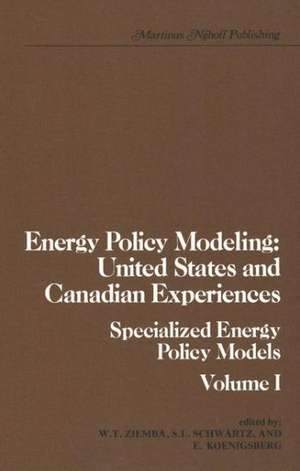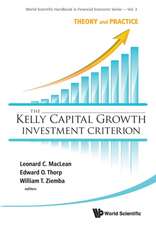Energy Policy Modeling: United States and Canadian Experiences: Volume I Specialized Energy Policy Models
Editat de William T. Ziemba, S. L. Schwartzen Limba Engleză Paperback – 14 oct 2011
| Toate formatele și edițiile | Preț | Express |
|---|---|---|
| Paperback (1) | 792.44 lei 38-44 zile | |
| SPRINGER NETHERLANDS – 14 oct 2011 | 792.44 lei 38-44 zile | |
| Hardback (1) | 957.62 lei 6-8 săpt. | |
| SPRINGER NETHERLANDS – 30 apr 1980 | 957.62 lei 6-8 săpt. |
Preț: 792.44 lei
Preț vechi: 1042.68 lei
-24% Nou
Puncte Express: 1189
Preț estimativ în valută:
151.65€ • 157.74$ • 125.20£
151.65€ • 157.74$ • 125.20£
Carte tipărită la comandă
Livrare economică 10-16 aprilie
Preluare comenzi: 021 569.72.76
Specificații
ISBN-13: 9789400987500
ISBN-10: 9400987501
Pagini: 420
Ilustrații: XX, 396 p.
Dimensiuni: 152 x 223 x 22 mm
Ediția:Softcover reprint of the original 1st ed. 1980
Editura: SPRINGER NETHERLANDS
Colecția Springer
Locul publicării:Dordrecht, Netherlands
ISBN-10: 9400987501
Pagini: 420
Ilustrații: XX, 396 p.
Dimensiuni: 152 x 223 x 22 mm
Ediția:Softcover reprint of the original 1st ed. 1980
Editura: SPRINGER NETHERLANDS
Colecția Springer
Locul publicării:Dordrecht, Netherlands
Public țintă
ResearchCuprins
I Energy Demand Modeling.- References.- 1 The Energy Demand Forecasting System of the National Energy Board.- 1.1 Overview of the Model.- 1.2 Recent Research in the Residential, Commercial, and Industrial Sectors.- 1.3 Applications of the Model.- References.- 2 A Policy Model of Canadian Interfuel Substitution Demands.- 2.1 Introduction.- 2.2 Approach.- 2.3 Model Specifications.- 2.4 Econometric Considerations.- 2.5 Estimation Results.- 2.6 Conclusions.- References.- 3 Inflationary Expectations and the Demand for Capital, Labor, and Energy in Canadian Manufacturing Industries.- 3.1 Introduction.- 3.2 Incorporation of Inflationary Expectations.- 3.3 Methodology and Data.- 3.4 Results and Policy Implications.- 3.5 Conclusions.- References.- 4 The Derived Demand for Energy in the Presence of Supply Constraints.- 4.1 Introduction.- 4.2 A Model of Producer Behavior Subject to Supply Constraints.- 4.3 An Estimated Production Structure for Canadian Manufacturing.- 4.4 Constrained Demand and Two-Stage Translog Model.- 4.5 An Empirical Example.- 4.6 Further Extensions and Applications.- References.- 5 The Residential Demand for Electric Energy and Natural Gas in Canada.- 5.1 Introduction.- 5.2 The Model.- 5.3 Estimation.- 5.4 Results and Interpretation.- 5.5 Conclusions.- References.- 6 An Econometric Model of Alberta Electricity Demand.- 6.1 Introduction.- 6.2 Electricity Prices.- 6.3 Residential Sector.- 6.4 Commercial Sector.- 6.5 Industrial Sector.- 6.6 Conclusion.- References.- 7 A Model for Forecasting Passenger Car Gasoline Demand.- 7.1 Introduction.- 7.2 New Car Sales.- 7.3 Market Share Equations.- 7.4 Probabilities of Survival.- 7.5 Estimation of Mileage Traveled.- 7.6 Fuel Economies and Urban/Nonurban Travel Split.- 7.7 Applications of the Model.- References.- II Energy Supply Modeling.- References.- 8 Choosing the Overall Size of the Strategic Petroleum Reserve.- 8.1 Introduction and Background.- 8.2 The Limitations of Cost-Benefit Analysis.- 8.3 A Parametric Bimatrix Game.- 8.4 Reserve Size and Embargo Length.- 8.5 Some Numerical Results.- 8.6 Conclusions.- 8.7 Post Scriptum.- References.- 9 Economic Modeling of Energy Supply from Burning Wood Wastes at British Columbia Pulp and Paper Mills.- 9.1 Introduction.- 9.2 Description of the Model.- 9.3 Evaluating the Economics of Fossil Fuel Replacement.- 9.4 Evaluating the Economics of Electricity Generation.- 9.5 Energy Pricing and Wood Waste Supply.- 9.6 Conclusions.- References.- 10 Simulation of Tar Sands Mining Operations.- 10.1 Introduction.- 10.2 Historical Background.- 10.3 Technical Background.- 10.4 Simulation Effort.- 10.5 Selection of Mining Equipment.- 10.6 Appendix A.- 10.7 Appendix B.- 10.8 Addendum (October 30, 1978).- 11 A Model of Energy Supply from Western Canada.- 11.1 Introduction.- 11.2 Structure of the Model.- 11.3 Illustrative Model Solutions and Comparative Statics.- 11.4 Concluding Remarks.- References.- 12 The Incorporation of New Technologies in Energy Supply Estimation.- 12.1 Introduction.- 12.2 Scope of the Approach.- 12.3 The Model.- 12.4 Observations on the Model.- References.- III Coal and Transportation Modeling.- References.- 13 Modeling U.S. Coal Supply and Demand.- 13.1 Introduction.- 13.2 Coal in Transition Project.- 13.3 Coal Development Scenarios.- 13.4 Model Results.- 13.5 Assessment of Energy Infrastructure Requirements.- References.- 14 The Transport of Energy by Rail.- 14.1 Introduction.- 14.2 Growth of Rail Capacity.- 14.3 Present Activities at CN.- 14.4 Concluding Remarks.- 15 Coal Slurry Pipelines: A Technology Assessment.- 15.1 Technology Assessment and the Role of the OTA.- 15.2 The Slurry Pipelines Study: An Overview.- 15.3 Modeling Techniques Used.- 15.4 The Results.- References.- 16 Costing the Movement of Western Canadian Coal to Thunder Bay: An Incremental Approach.- 16.1 Introduction.- 16.2 Systems Analysis.- 16.3 Tariff Schedules and Analysis.- 16.4 Policy Implications.- References.- 17 Simulation Modeling of Coal Terminals.- 17.1 Justification for Simulation Modeling.- 17.2 Modeling Considerations at Coal Terminals.- 17.3 Case Study: Richards Bay, South Africa.- 17.4 Conclusion.- 18 A Short Run Model of the World Petroleum Network Based on Decomposition.- 18.1 Introduction.- 18.2 Overall Description of Martinet.- 18.3 Computational Improvements.- Reference.- IV The Problems and Interactions of Energy, Environment, and Conservation.- References.- 19 Projections of Solar Energy Utilization: A Guide to Federal Planning.- 19.1 Introduction.- 19.2 Capturing the Dynamics of the Solar Transition: The Spurr Model.- 19.3 The Buildings Components: An Example.- 19.4 Summary of Projections of Solar Energy Utilization.- References.- 20 Modeling the Economic and Environmental Impacts of Alternative Electric Utility Futures.- 20.1 Introduction.- 20.2 The Utility Simulation Model.- 20.3 Applications of the Modeling and its Results.- 20.4 Usefulness of the Integrated Approach to Modeling.- References.- 21 Systems Approach to Assessing Electricity Conservation Initiatives.- 21.1 Introduction.- 21.2 The Rate Simulation Model.- 21.3 Concepts of Technological Modeling.- 21.4 Results of Applying the Model to Alternative Rate Structures.- References.- 22 Saving Half of California’s Energy and Peak Power in Buildings and Appliances.- 22.1 Overview.- 22.2 Case Studies: Optimized Buildings and Appliances.- References.











